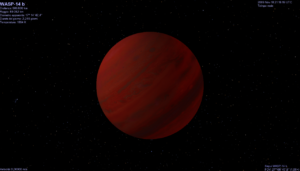 All eyes are back on the sky as the Hubble Telescope continues to unveil little known facts around the universe. The Hubble Space Telescope is back in the news and this time for honing in on the first planet to have a stratosphere, within our solar system. The planet is WASP-121b and the Hubble telescope was able to bring in solid data that showcases the possibility of an actual stratosphere. A stratosphere, for those not in the know, is a layer within the atmosphere whereupon the temperature raises as the altitude gets higher.
All eyes are back on the sky as the Hubble Telescope continues to unveil little known facts around the universe. The Hubble Space Telescope is back in the news and this time for honing in on the first planet to have a stratosphere, within our solar system. The planet is WASP-121b and the Hubble telescope was able to bring in solid data that showcases the possibility of an actual stratosphere. A stratosphere, for those not in the know, is a layer within the atmosphere whereupon the temperature raises as the altitude gets higher.
Scientists are calling the WASP-121b a ‘hot Jupiter’. The WASP-121b is actually larger than Jupiter in terms of mass, weighing in at 1.2 times that of our more familiar planet, and it is 1.9 times as wide via radius as Jupiter. What makes the WASP-121b even more interesting is how fast it rotates around the sun. The WASP-121b orbits the sun once every 1.3 DAYS. In fact, if this little gassy exoplanet were any closer to our star then it likely would be ripped to shreds. Proximity to the sun allows for the WASP-121b to have surface temperatures near 4,600 degrees — more than hot enough to straight up liquefy metal.
Scientists were able to study this neat little planet by looking at how molecules on WASP-121b react to different wavelengths of light. The Hubble played an impressive role in this process as it was used to perform a spectroscopy, showing the full spectrum of the planet. Tiffany Kataria is based out of the Jet Propulsion Laboratory for NASA, located in Pasadena, CA, had this to say: “We’re excited to explore at what longitudes this behavior persists with upcoming Hubble observations.”
Thomas Evans is leading the research on the WASP-121b and he was the one to first detect the spectral type signatures within the atmosphere of the faraway exoplanet. His identification of these signatures was due to his keying in on water molecules. As Evans and his team peeled back layer after layer, ultimately getting to the bottom troposphere, they were able to conclude that temperatures continually decreased.
While this information may only be interesting to some, it marks a significant step forward for the work that Evans has been doing. Evans believes that this information allows scientists to come to a more full understanding of exoplanets and how they mimic and differentiate from our own planet.
https://scitechdaily.com/hubble-detects-an-ultrahot-gas-giant-exoplanet-with-a-stratosphere/











